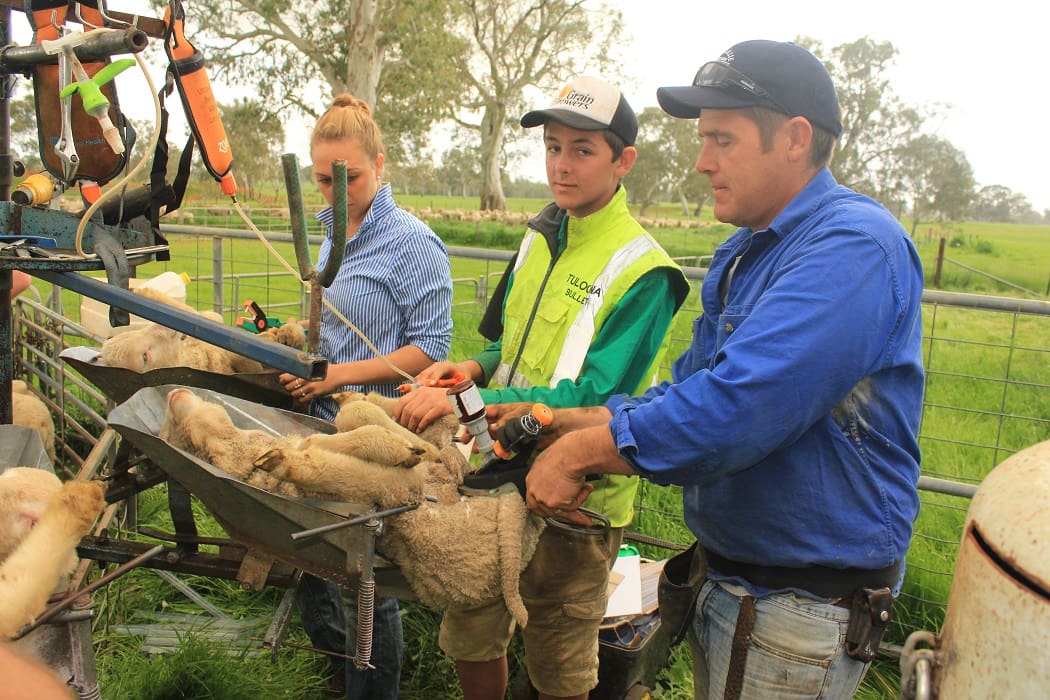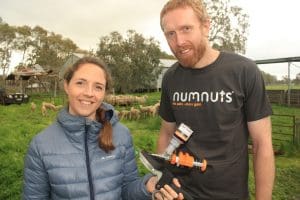
Harrow sheep producer Michael Craig, far right, uses Numnuts, watched by Campbell Craig and Kate Moran.
AUSTRALIAN sheep producers will be able to use the world’s first hand-held combined pain relief delivery, and lamb castration and tail docking tool – Numnuts – next year.
Final Australian testing of the Scottish-conceived tool is underway in selected flocks in New South Wales and Victoria prior to the product’s planned “soft” launch at agricultural shows in Australia in mid-2019.
The tool enables an operator to apply rubber rings for castration and tail-docking, and also inject 1.5ml of local anaesthetic at the base of a lamb’s testicle or tail for relief from the immediate pain experienced from the procedures. The local anaesthetic used is quick-acting and a powerful ‘nerve blocker’.
Design engineers from the Scottish firm 4c Design, Hannah Jenkins and John Ritchie, were at Michael and Jane Craig’s Harrow property ‘Tuloona’ this week doing commercial product testing following research and development trials carried out by CSIRO to prove the applicator’s pain relief efficacy. John said 4c Design had been testing and refining the product for several years on research farms with the CSIRO in Armidale, New South Wales.
“We are just testing now whether what we have designed is usable in a commercial environment and whether there are any robustness issues in the field, so we can get ready for launch next year.
“This prototype is version 15 and we are still looking at different options for some of the materials,” Hannah said.
Numnuts commercialised for sheep first, cattle next

4c Design engineers Hannah Jenkins and John Ritchie with the latest Numnuts tool.
The latest Numnuts version is expected to be used on up to 8000 lambs over two weeks as part of a project supported by Meat and Livestock Australia. The company also intends to develop the technology for use with cattle.
John said the local anaesthetic works within a few minutes and for up to an hour after application to deaden the initial acute pain spike from either procedure.
“We haven’t got a final cost yet; we think it will be around 65-70 cents a dose in the early years.
“Longer term we are working hard to try to reduce the cost down to about 50 cents a dose once all the various commercial factors are taken into account.”
Hannah said farmers looking to maintain accreditation for programs like the Responsible Wool Standard need to provide pain relief for castration and tail docking. John said the other benefits of using pain relief include lambs being able to mother up quicker for earlier movement back to paddocks. There are indications there is also a weight grain benefit, although formal statistical trials have not yet been carried out, he said.
John said 4c Design wanted to see how the tool fitted in with the Australian lamb marking system and how operators were able to incorporate the tool’s dual functions of injecting lignocaine and applying a rubber ring. The bottle of local anaesthetic is replaced after 65 doses. The robustness of the tool in commercial operation is also being assessed to minimise potential for breakages.
The latest Numnuts tool involves a separately operated plunger for injecting the lignocaine enabling the operator to find the correct intramuscular position and avoiding hitting bone. Operator safety is included in the design and the tool’s needle is only exposed when the plunger is engaged.
Numnuts benefits to lambs immediately obvious
In proof-of-concept trials, there was a significant decrease in pain behaviour such as ‘tucked up’ posture, bleating and lying down. Michael Craig said this was noticeable with Numnuts use this week. The Numnuts pain relief injection was also used on lambs who had their tails removed with a gas knife.
“It seems to alleviate 95 percent of the pain.”
Tuloona is also weighing lambs after marking to assess any weight gain advantages of Numnuts use.
“The big difference you see right away is that the rolling around of male lambs after marking stops – we are happy on that level.”
The ewes with their Numnut-treated lambs will be able to be moved earlier back to their paddocks, Mr Craig said.
“We found when we ceased mulesing that our management could be more flexible, and it is true for this too.
“And what we are finding is that lamb marking is going at the same speed, it is not slowing down, which is important,” Mr Craig said.
“We are really quite impressed that it seems quite idiot-proof, which is good.
“All the things we are doing on farm now involve mitigating pain, so what we are doing to our animals is what city people would expect for their pets,” he said.
“A lot of the consumer who are going to purchase our products are disconnected from our world now, but if we can hand-on-heart prove that we do care for our animals and anything invasive that we do is done with pain relief….our consumers expect that.”
He said Tuloona ceased mulesing 10 years ago and now there is a pain relief solution for castration and tail docking.
“With this and our production system, which is free range and natural, we should be able to attract a premium for our meat and wool.”
Numnuts was also used at Tim and Georgie Leeming’s lamb marking at Pigeon Ponds this week. Mr Leeming noted the quick recovery of the Numnuts-treated lambs.
Contractor Peter Roberts from J & P Stock and Contracting at Kanagulk said using the tool was more time-consuming, but it fitted in well with the lamb marking process.
“And from an animal welfare point of view it is pretty good.”
The Numnuts tool itself is expected to retail at about $200 and 500 tools will initially be made available to selected farmers. Farmers wishing to be early adopters can register their interest on the Numnuts website – numnuts.co.uk
NumNuts is the result of a partnership between Meat & Livestock Australia and Scottish engineering firm 4c Design, which was established during the MLA-funded development of a barber’s pole worm vaccine, BarberVax, by Moredun Research Institute in Scotland. Australian Wool Innovation also contributed to the project, with research carried out by Moredun and the CSIRO.

HAVE YOUR SAY